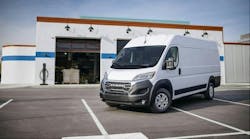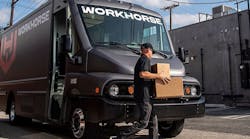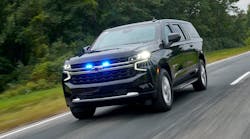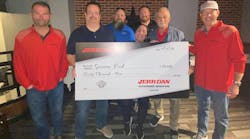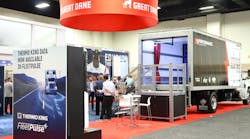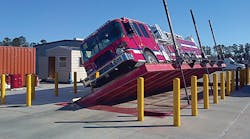Fire apparatus is a relatively small but specialized market. Almost every unit is custom designed and equipped.
The vehicles range from small brush and EMS vehicles built on commercial chassis to 60,000-lb heavy rescue and aerial type vehicles built on custom Class 8 trucks.
Tenders, which carry large amounts of water and are usually equipped with relatively small pumps, are also part of the mix. The majority of fire apparatus are pumpers. They range from straightforward pumping rigs, with various size pumps from 1,000 (250) gpm to 3,000 gpm dependent on customer needs, with water tanks from 750 (50) gallons up to 3,500 gallons. All such vehicles also carry other equipment such as hose, ground ladders, rescue tools, and a host of firefighting tools and equipment. Personnel carried on fire apparatus will vary from three on simple commercial chassis to eight for custom chassis and bodies. Body styles are greatly varied by manufacturer and by customer needs and wants.
Several years ago the Fire Service was plagued with a number of rollover incidents with significant property damage as well as personnel injury and deaths. In addition to the monetary and human loss in such incidents it was obvious the fire apparatus didn’t get to the fire, thus indirectly causing even greater losses. And the loss of an apparatus, which could not be replaced overnight, reduced the ability of a fire department to provide fire protection in its response area.
Over a ten year period statistics gathered showed some 20-35% of firefighter deaths were because of vehicle accidents, many of them rollovers. A review of such rollover incidents indicated there were several causes, including driver error, road conditions, and high vertical centers of gravity. Several automotive industry standards such as SAE J2180 and various NHTSA relate to vertical center of gravity values, but there was no specific fire apparatus industry standard. Something had to be done to reduce the toll of rollover incidents.
The National Fire Protection Association is an authoritative source on public safety and develops, publishes, and disseminates more than 300 consensus codes and standards. Several of the standards relate to motorized fire apparatus and (while voluntarily adopted) are the de-factor law for the industry. The most important such standard pertaining to apparatus design and performance is NFPA 1901 Automotive Fire Apparatus. Each NFPA standard is generated and monitored by a voluntary committee composed of Apparatus Manufacturers, Fire Department representatives, insurance company representatives, special experts, and regulatory agencies who update the contents on a general 4 year cycle, although amendments and changes may be submitted at any time for review by the Committee.
After considerable discussion, research, and conversations the NFPA 1901 Committee recommended an addition to the Standard that would provide for three methods of addressing the problem of rollover. Each of the three solutions has pros and cons, but provides flexibility for small to large manufacturers, using custom or commercial chassis, to meet the Standard.
The specific section of the 1901(2009 edition) Standard which relates to the problem of rollover is 4.13 Vehicle Stability.
Section 4.13.1.1 of NFPA 1901 provides that: (1) an electronic stability control (ESC) be provided, (2) the apparatus shall remain stable to 26.5 degrees in both directions when tested on a tilt table in accordance with SAE J2180 A Tilt Table Procedure for Measuring the Static Rollover Threshold for Heavy Trucks, (3) the calculated or measured vertical center of gravity (vcg) is no higher than 80% of the rear axle track. All tests to be conducted with the apparatus loaded to its operational weight, i.e., water, equipment, manpower, etc. In addition the longitudinal and traverse cg values must be within criteria.
While there were three methods listed to meet the NFPA 1901 requirement, each had its advantages and disadvantages:
• Calculation method, in which the center of gravity of each part or assembly of a vehicle is entered into a spreadsheet and ultimately produce the longitudinal, lateral, and vertical centers of gravity is a cumbersome and sometime inaccurate measure.
• Electronic stability control (ESC) is an expensive solution (although prices are coming down) and is a maintenance problem for some. And some drivers simply do not want the computer to take away their ability to control brake and throttle operations.
• Tilting to the vehicle to a specific angle. After much discussion, the consensus of the committee was that a lateral acceleration of 0.5g was the danger value for a tipping point. Keeping in mind the normal drag factor (coefficient of friction) between a roadway and tires is 0.7 and that a 0.5g lateral acceleration will make a driver rather nervous.
Such a lateral acceleration may be produced by simply driving the vehicle in a circle of specified radius at a specified speed (aradial = v^2/r). Obviously, such is pretty hard on tires and chassis. Plus, if a vehicle fails the test, it really fails. Simply tilting the vehicle to a particular angle accomplishes the same thing, but without any danger of damage.
The angle for fire apparatus was determined to be 26.5 degrees (the arctangent of 0.5) with off-road and crash-rescue vehicles being tilted to 30 degrees (the equivalent of a 0.58g lateral acceleration). Obviously, a restraint system is employed to keep a vehicle from completely turning over if it cannot pass the appropriate test.
Seeing the wisdom of using the tilt table alternative, which relies on Mother Nature’s physics, Ferrara Fire Apparatus, a fire apparatus manufacturer in Holden, Louisiana, elected to build a large tilt table. This table is a 10’ x 50’ platform, capable of tilting vehicles up to 150,000 lbs. to close to 40 degrees. There are wheel scales at the end of the platform which provide for the automatic evaluation of lateral and longitudinal cg values.
In addition to their own products, the tilt table is used by other manufacturers. Recently BrandFX Body Company of Fort Worth, Texas, used the facility to test their latest designs. All passed the NFPA test with flying colors, and one design was tilted to the upper limit of the table—some 39.2 degrees—without tipping. All this with a full tank of water and all equipment, with ballast simulating the weight and location of crew members.
While tilt testing won’t eliminate fire apparatus rollovers, it does prove the design and performance abilities of the vehicles tested. The singular constant in all operations is gravity. Tests that do not rely on anything other than gravity are quite constant.
Getting equipment and personnel to and from the scene of an emergency is important. Tilt table testing is helping to ensure the safe operation of emergency vehicles.
A.K. Rosenhan, PE, CEng is the fire services coordinator for Oktibbeha County, Mississippi and does consulting work for fire apparatus and equipment manufacturers.
